 |
Convert DAT to BMP Sequence
|
The BMP file format, also known as bitmap image file or
Device Independent Bitmap (DIB) file format or simply a bitmap, is a raster graphics
image file format used to store bitmap digital images, independently of the display
device (such as a graphics adapter), especially on Microsoft Windows and OS/2
operating systems. The BMP is stored uncompressed; so it's a lossless image format,
but file size is very big.
DAT to BMP Converter Software converts DAT to BMP sequence files.
With the software, you could get every frame image of DAT in BMP format. The
converter software also supports other output image formats such as JPG,
PNG, and TIFF. You can convert only a part of DAT to BMP instead of the entire
file. And you can set how many frames per second to be extracted with the software.
The output BMP files look something like this.

The software also supports other formats and portable devices such as OGM, AMR, OGG Vorbis, MPA, MP2, iPhone, Windows Phone,
etc. The software could convert DVD to Windows Phone, EVO to FLV, H263 to AC3, OGG to 3G2, MOD to WMV, and so on.
DAT to BMP Software supports batch conversion and, is compatible
with Windows 10/8/7/Vista/XP/2000.

What is DAT?
In VCD's, the MPEG stream is stored as a .dat file. Some Blu-ray and HD-DVD
players also retain support, as do CBHD players as well. Video CD players
should play the video from the DAT files without having to open the files
manually. VCDs are playable in dedicated VCD players, most DVD-Video players,
personal computers, and some video game consoles. Similarly, the audio
frequency range is limited to those sounds most clearly heard by the human
ear. The disc format is also supported using Windows Media Player Classic
variations and VLC Media Player both support VCDs natively. 352x240 (or
SIF) resolution was chosen because it is half the vertical, and half the
horizontal resolution of NTSC video. Overall picture quality is intended
to be comparable to VHS video. VCD video is mostly compatible with the
DVD-Video standard, except for any video encoded at 23.976 frames per second,
which must use 3:2 pulldown. Video specifications: Codec: MPEG-1; Resolution:
352x240 (NTSC), 352x288 (PAL/SECAM); Aspect Ratio: 4:3 (NTSC), 4:3 (PAL/SECAM);
Framerate: 29.97 or 23.976 frames per second (NTSC), 25 frames per second
(PAL/SECAM); Bitrate: 1,150 kilobits per second; Rate Control: constant
bitrate. Although many DVD video players support playback of VCDs, VCD
video is only compatible with the DVD-Video standard if encoded at 29.97
frames per second or 25 frames per second. This approximates the (overall)
resolution of an analog VHS tape, which, although it has double the number
of (vertical) scan lines, has a much lower horizontal resolution. The MPEG-1
compression used records mostly the differences between successive video
frames, rather than write out each frame individually.
What is BMP?
The .bmp file extension is given to raster image files, also known as bitmap
image files. These non-compressed image files contain a file header and
the pixels of the associated bitmap. Indexed color images may be compressed
with 4-bit or 8-bit RLE or Huffman 1D algorithm. OS/2 BITMAPCOREHEADER2
24bpp images may be compressed with the 24-bit RLE algorithm. The 16bpp
and 32bpp images are always stored uncompressed. Note that images in all
color depths can be stored without compression if so desired. The BMP format
stores color data for each pixel in the image without any compression.
For example, a 10x10 pixel BMP image will include color data for 100 pixels.
This method of storing image information allows for crisp, high-quality
graphics, but also produces large file sizes. The BMP file format, sometimes
called bitmap or DIB file format (for device-independent bitmap), is an
image file format used to store bitmap digital images, especially on Microsoft
Windows and OS/2 operating systems. Naturally, bitmap images saved at higher
number bits per pixel are greater quality images than those saved at lower
number bit images, but the file size will be larger. When the size of gap1
and gap2 is zero, the in-memory DIB data structure is customarily referred
to as "packed DIB" and can be referred to by a single pointer
pointing to the beginning of the DIB header. The integers in a BMP file
are stored in little endian format, another name for the Intel format.
This is because the BMP format was actually created for computers with
Intel processors. A DIB is normally transported in metafiles (usually using
the StretchDIBits() function), BMP files, and the Clipboard (CF_DIB data
format).
How to Convert DAT to BMP Sequence?
- Free Download DAT to BMP Conversion
Software
- Install the Program by Step-by-step Instructions
- Launch DAT to BMP Software
- Choose DAT Files

Click "Add Files" to choose DAT files.

Choose one or more DAT files you want to convert and then click Open.
DAT to BMP Software will open DAT files and get file information
of the file such as width, height, frame rate, video bit rate, audio sample rate,
audio bit rate, audio channels, and then display the information of DAT file
at conversion list.
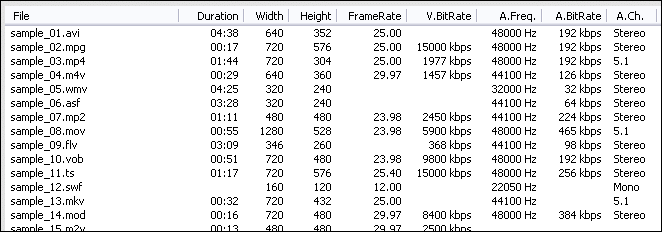
- Choose Output Format
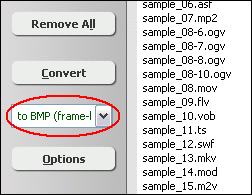
Click on combo-box of output format and then choose "to BMP (image sequence)".
- [Optional, for advanced user]
Set BMP Encoding Parameters
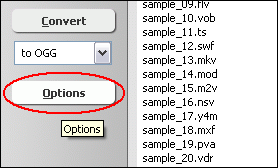
If you want to change BMP encoding parameters such as frame rate, video size,
aspect ratio, and so on, please click "Options".
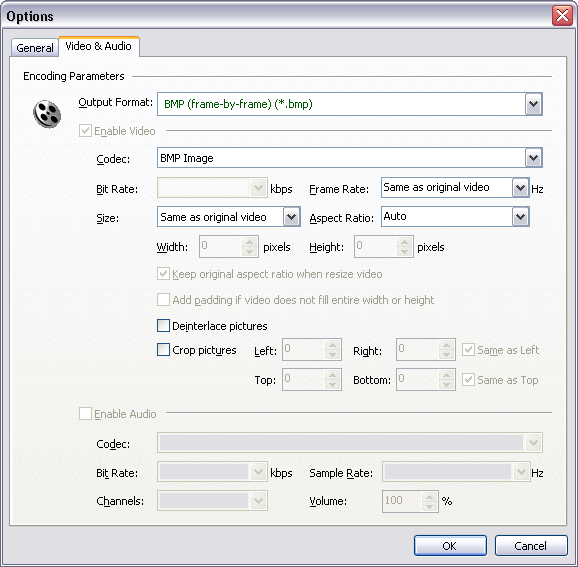
And then, switch to tab "Video & Audio" and choose "BMP
(image sequence)" at "Output Format", and then set options
for image encoding.
- Convert DAT to BMP
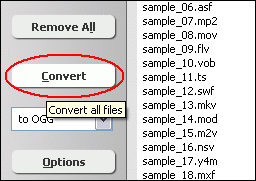
Click "Convert" to convert DAT to BMP sequence.

The software is converting DAT files to BMP.
- View and Browse BMP Files
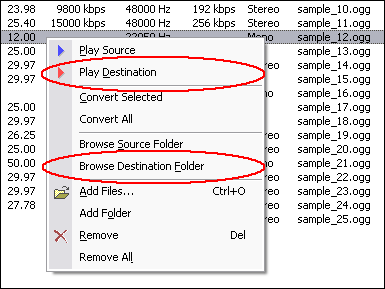
When conversion completes, you can right-click converted item and choose "Play
Destination" to view the first outputted BMP file; or choose "Browse
Destination Folder" to open Windows Explorer to browse the outputted BMP
files.
- Done
Top
DAT to BMP Software is 100% clean and safe to
install. It's certified by major download sites.

Convert DAT to BMP Related Topics:
|












